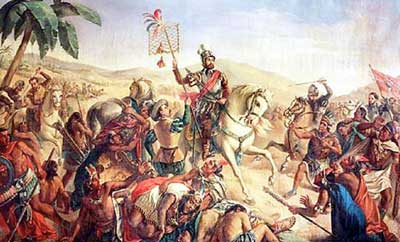 cannon, and a few harquebuses, muskets, and pistols Pizarro entered Cajamarca with 180 soldiers and 37 horses. That was enough Yet the Aztec capital, Tenochtitlan, was then five times larger that Madrid and had double the population of Seville, Spain's largest city, and in Peru Pizarro met an army of 100,000 Indians.
cannon, and a few harquebuses, muskets, and pistols Pizarro entered Cajamarca with 180 soldiers and 37 horses. That was enough Yet the Aztec capital, Tenochtitlan, was then five times larger that Madrid and had double the population of Seville, Spain's largest city, and in Peru Pizarro met an army of 100,000 Indians.
Bacteria and viruses were the most effective allies the Europeans brought with them, like biblical plagues, smallpox and tetanus, various lung, intestinal, and venereal diseases, trachoma, typhus, leprosy, yellow fever, and teeth-rotting caries. Smallpox was the first to appear. Must not this unknown and horrible epidemic, which produced burning fever and decomposed the flesh, be a chastisement from the gods? The invaders "moved into Tlaxcala," one native eyewitness reported, "and then the epidemic spread: cough, burning hot pustules." Reported another: "The contagious, oppressive, cruel pustule sickness brought death to many." The Indians died like flies; their organisms had no defense against the new diseases. Those who survived were feeble and useless. The Brazilian anthropologist Darcy Ribeiro estimates that more than half the aboriginal population of America, Australia, and Oceania died from the contamination of first contact with white men.